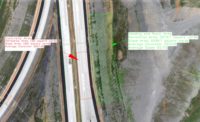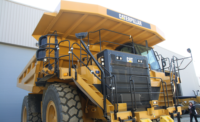Reporting strong sales in construction equipment but seeing ongoing expenses related to tariffs and reduced demand in the North American energy sector, Caterpillar offered tempered expectations for the equipment manufacturer’s performance for the rest of the year.
Construction was a highlight for Cat in the second quarter of 2019, with a record $6.5 billion in sales, an increase of $295 million over Q2 2018. But the company’s overall growth in sales and revenue was only 3%, with gains in the construction and mining sectors offset by decreased demand in the energy sector. The company's second quarter performance also fell short of analyst expectations, with unexpected slow sales in the oil and gas market coming on top of previously unbooked restructuring costs. Caterpillar's stock was down four points, or roughly 3%, in the days after the July 23 earnings announcement.
Expenses related to an ongoing restructuring of the company and unsold inventories somewhat offset positive sales in construction equipment, but the U.S. energy market was cited by the Caterpillar executives as the primary drag on its earnings in the second quarter. “While some customers appear to be more cautious about making large capital expenditures, including in oil and gas, we continue to expect modest sales growth for the year,” said Cat CEO Jim Umpleby in a call with analysts on July 23.
Volatile natural gas prices were at the root of the issue, according to Umpleby, but he expects that the rest of the year will level out. “We expect our sales into the Permian Basin will strengthen in the fourth quarter as takeaway capacity improves,” he said, discussing the disappointing sales numbers for Caterpillar’s gas-fired reciprocating engines in its energy unit.
Construction equipment sales remain strong despite a price increase related to tariffs on steel and other materials. Caterpillar is also in the midst of a multiyear reorganization, and has been working to reduce lead times and adjust its inventory mix to better respond to dealer demand. North America drove its construction equipment sales, and Umpleby cited ongoing investments in infrastructure at the state and local level offsetting weak residential construction activity. Other areas of the globe saw relatively flat sales for Cat, with competitive pricing in China cited as a major obstacle to growing the company's presence in the Asia and Pacific regions.
Caterpillar says it has largely absorbed the increased input costs that resulted from tariffs on steel and other materials thanks to a considerable price increase it put in place earlier this year. “Manufacturing costs increased by $328M, due to higher material costs including $70M in tariffs,” said Andrew Bonfield, Cat CFO, during the earnings call.
Not only have price increases earlier this year offset much of the input costs, Bonfield noted the company is even seeing signs of material prices dropping in the immediate future. "We're starting to see some things like steel costs come down. Steel, obviously, we do a lot of our steel buying on a contractual basis and there is a lag, but we are starting to see some of those things flow through as well."
Analysts responses to Cat's lowered expectations for the rest of 2019 were mixed, with some questioning Cat's optimism about a recovery in energy markets and its own efforts at working through inventories. "Cat tempered its outlook in oil and gas, although some question whether it is enough," wrote Jamie Cook, managing director for equity research at Credit Suisse in a note to investors. "Bottom line, investors do not want an inventory correction heading into FY2020 potentially weighing down on earnings."



